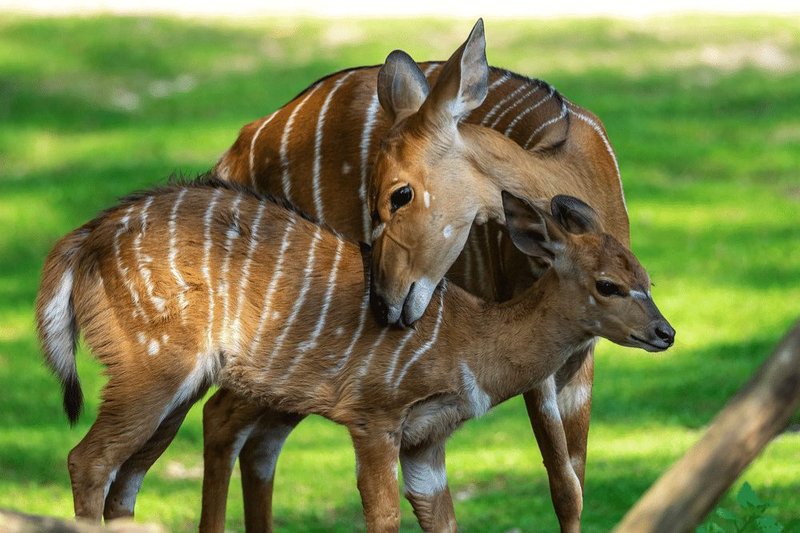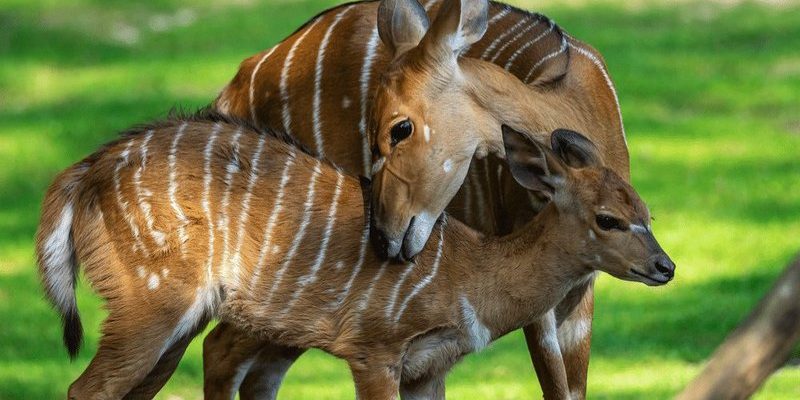
Finding nyalas in the wild can feel like spotting a rare gem among a treasure chest. They thrive in the dense brush and woodlands of Southern Africa, where their unique features and behaviors allow them to blend seamlessly into their environment. Let’s explore ten fascinating facts about the nyala that shed light on its unique life and the role it plays in its ecosystem.
1. Unique Physical Features
Nyala are one of the most visually striking antelopes out there. Males, with their impressive spiral horns, can weigh up to 110 pounds and stand about a meter tall at the shoulder. Their dark, shaggy fur is marked with distinctive white markings, including stripes on their face and legs, which help them blend into the forest undergrowth.
Females, on the other hand, are a bit smaller and have a lighter, tawny coat. They lack the prominent horns but have a subtle beauty of their own, often gathering in small groups, gently munching on grass and leaves. This difference in appearance is more than just aesthetics; it’s known as sexual dimorphism and plays a role in mating and social dynamics. Honestly, if you ever see these animals side by side, you’ll appreciate how their unique features serve different purposes in their lives.
2. Habitat Preferences
You might wonder where to find these elusive antelopes. Nyala prefer the dense woodlands, thickets, and bushveld of Southern Africa, particularly in areas with abundant cover. Think of it as their cozy home—where they can hide from predators and find plenty of food. They love areas where there’s a mix of trees and open grass, allowing them to forage safely.
Interestingly, nyala are not great at long-distance running, so they rely heavily on their habitat for protection. When threatened, they’ll often stand still and use their natural camouflage, relying on their surroundings to keep them hidden. This is a fascinating survival tactic; it’s almost like playing hide and seek, where they know the perfect spots to blend in.
3. Social Structure of Nyala
Nyala have an intriguing social structure that varies between males and females. Males are generally solitary or form small bachelor groups, while females tend to stick together in larger groups. This difference highlights their unique roles within the species—males are tough competitors, often showing aggression toward one another during mating season, while females prioritize nurturing their young.
The females can be quite social, often raising their calves together. This cooperative caretaking can increase survival rates for the young. Imagine a small group of mothers looking out for each other’s calves; it’s like a little daycare in the middle of the wild!
4. Diet and Feeding Habits
Nyala are browsers, which means they primarily feed on leaves, fruits, and shrubs. Their diet is quite flexible, and they can adapt to what’s available in their habitat. This adaptability is crucial, especially during dry seasons when food becomes scarce.
You might be surprised to know that nyala have a special preference for certain plants and grasses. They tend to be selective feeders, choosing the most nutritious options. Their long legs and flexible necks allow them to reach high branches, making them efficient foragers. Just think about how the way they eat has evolved to suit their environment—it’s like they’re nature’s little grocery shoppers!
5. Breeding and Life Cycle
The breeding season for nyala generally occurs during the rainy season when food is abundant. Males will display their strength and flair through elaborate courtship displays, which can involve vocalizations, posturing, and even sparring with other males. Here’s the thing: these displays aren’t just for show; they play a crucial role in attracting females.
Once a female chooses a mate, she’ll give birth after a gestation period of about seven months. The calf is usually hidden in dense cover for several weeks after birth to protect it from predators. This strategy is key to survival; it’s almost like playing a game of hide and seek, where the youngest players are the most vulnerable.
6. Predators and Threats
In the wild, nyala face several predators, including lions, leopards, and hyenas. Being on the menu means they need to stay alert and be strategic about their movements. Since they prefer dense areas, they often rely on their strong instincts to evade these threats.
Threats aren’t just limited to natural predators; habitat loss due to human activities, such as farming and urban development, poses a significant risk to their populations. Conservation efforts are crucial to ensure that these beautiful creatures continue to thrive in their natural habitats. Every little bit helps when it comes to protecting not just niyala but the entire ecosystem they belong to.
7. Unique Adaptations
One of the most fascinating aspects of the nyala is its remarkable adaptations to its environment. For instance, their large ears help them pick up sounds from a distance, allowing them to detect predators before it’s too late. Additionally, their keen sense of smell helps them identify danger or locate food.
Their behavioral adaptations are just as interesting. When foraging, they often move silently and rely on their color to blend in with the foliage, reducing the chances of being spotted. It’s amazing how these traits have evolved to enhance their survival—like a finely-tuned machine working perfectly in sync with nature.
8. The Nyala’s Role in Ecosystems
Nyala play an essential role in their ecosystems. As herbivores, they help manage plant growth by grazing on various vegetation. This not only prevents overgrowth but also promotes biodiversity. When they eat certain plants, they help disperse seeds, supporting new plant life.
Moreover, their presence supports the food chain. By providing sustenance for larger predators, nyala help maintain a balanced ecosystem. It’s a reminder of how interconnected everything is in nature, and how every species, from the smallest insect to the largest mammal, has a part to play.
9. Conservation Status and Efforts
Currently, the nyala is classified as “Least Concern” by the IUCN Red List, which is good news. However, this doesn’t mean we can take them for granted. Their habitats are under threat from agriculture and urbanization. Conservation programs are in place to protect their natural environments and educate communities about the importance of preserving wildlife.
Local and international organizations work tirelessly to ensure the survival of nyala in the wild. It’s a collective effort that involves sustainable practices and habitat restoration. Supporting these initiatives is crucial for ensuring that future generations can enjoy seeing these magnificent creatures in their natural habitats.
10. Fun Facts About Nyala
If you’re looking for some light-hearted trivia about nyala, here are a few fun facts:
- The name “nyala” comes from a South African word, which reflects their local importance.
- They are known to be quite vocal, making a range of sounds to communicate.
- During courtship, males may engage in “stotting,” a behavior where they leap high in the air to show off their fitness.
- Young calves can stand and walk just a few hours after birth—a vital skill for survival!
These tidbits not only highlight their interesting behaviors but also remind us of the diversity of life in the animal kingdom.
In summary, the nyala isn’t just another antelope; it’s a fascinating creature with a rich tapestry of characteristics and behaviors. From its stunning appearance to its vital role in the ecosystem, learning about them deepens our appreciation for nature. Let’s keep advocating for their preservation and supporting efforts to keep our wildlife thriving!

